**Please note that footnotes are not optimized for mobile viewing. Please be sure to click through them, or read this essay on a standard monitor. In addition to references, the footnotes also contain important distinctions and clarifications salient to the content of this essay.**
—
While representations of gender have received attention for most media, stories, and games, the topic of gender in live action role-playing games (larps) is particularly important because of the degree of embodiment that is uniquely characteristic of the medium. When role-playing a (gendered) character, the player’s own body is at play, a fact that tends to constrain the performance, as both out-of-game and in-game expectations of attributes such as beauty, strength, leadership, and friendliness create restrictions on what is considered an authentic, true, or “real” performance of masculinity or femininity. This standard of believability in larp derives from powerful social norms and thus tends to reify the dominant gender binary of feminine=female and masculine=male as well as heterosexual relationships as the default. In this essay, we will explore the affordances of two approaches to writing and casting gendered characters in theatre-style larps in order to demonstrate how they each replicate or subvert dominant ideologies of gender and sexuality, and how larp may open a space for performances of possibility: a wider range of genders, sexualities, and bodies that portray them.
First, we will address the theoretical foundations that inform this approach to understanding gender as performance. Next, we will address two styles of game design in theatre-style larps. Although there are many genres and styles of larp, we will be specifically examining theatre-style larps that feature characters that are pre-written by a game designer, as opposed to campaign or boffer larps—which use player-generated character creation techniques based on hierarchical attributes in the style of Dungeons and Dragons—or more deliberately experimental or artistic larps designed specifically to explore gender. Within this genre of theatre-style larp, we will first describe mainstream theatre-style larp design, exemplified in larps run at gaming conventions in the U.S. and the U.K., an approach in which the game designer and/or game master assigns gender and sexuality to players by means of pre-written characters. In contrast, we will then address the newer larp practice of gender-neutral casting, in which all characters are written as gender-neutral, leaving the assignment of gender and sexuality up to the player. Based on our observations as game participants, we will analyze two parlor larps from the larp convention Intercon (Chelmsford, MA; 2014, 2015) alongside the new popular larp, College of Wizardry (Poland, 2014). While neither game design can fully ensure that a more broad performance of gender and sexuality is enacted in the game, we assert that the gender-neutral design, by giving greater agency to players in choosing how gender is performed and what kinds of character relationships are formed, allows for more performances of possibility outside of merely reifying a gender binary and default heterosexuality.
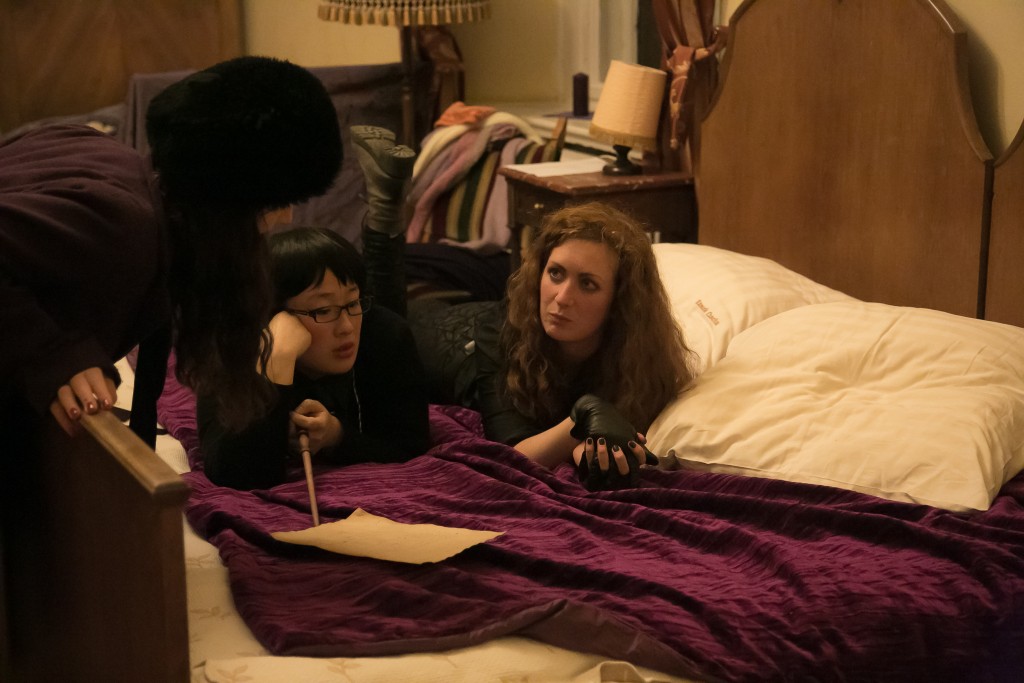
Gender as Performance
In the past fifty years, sociologists, psychologists, and cultural studies scholars have demonstrated that gender and sexuality are societal constructs and are not innate or biologically determined. By this view, gender is portrayed through “language, gesture, and all manner of symbolic social sign” and gender identity is “compelled by social sanction and taboo.” Gender becomes a matter of conviction, composed of a complex system of semiotic signs that produce a cohesive sense of a singular gender role. These signifiers—such as clothing style, pitch of voice, and physical gestures—are associated with gender-based assumptions about ability, sexuality, and behavior. The notion that there are only two options for gender identity—male or female—is a result of gender performativity, which philosopher Judith Butler defines as the repetition, over time, of a particular performance, creating an expectation that the performance continues and a sense of fixedness of identity. Sociologist Chris Brickell notes that the gender performance of individuals is “subject to the surveillance of themselves and others” and people “may be held to account if gender is not done in an approved manner.” And, as Butler has noted, this process of surveillance and approval can result in life-or-death consequences for those whose gender performances break the categories in some way, which is why representations of gender are worth critiquing.
The role-play in a larp mirrors this role-play of everyday life, as players deliver a gendered performance that is “compelling illusion, an object of belief” that is upheld during the game and affects the performance of others interacting with the player. Since the gender binary is the dominant norm in Western society, it tends to be replicated within the games created by members of that society. Larp participants tend to know where the boundaries, expectations, and tropes are for each gender since “rules and norms about what constitutes ‘competent’ gendering are established, enforced, and changed in particular contexts,” such as in a larp. Indeed, a larp is often designed with the assumption that its players will know, understand, enact, and enforce these norms as a way to quickly create a shared fictional space within which to play. Thus, as a result of taking on a role in a larp, players may become more consciously aware of the performative nature of gender in everyday life.
Although cultural conceptions of gender performances and the believability of the material bodies that portray them are brought into a larp through its design, players in larps have the ability to make choices that can subvert these standards. According to game scholar Markus Montola, in a larp “the decisive power to define the decisions made by a free-willed character construct is given to the player of the character.” The player may use this power to reject the forced choices of a gender binary, and to create instead a “third space of possibility within which all binaries become unstable.” This space of possibility, however, enacted by an individual player, is only as good as the shared space of possibility that the players create together.
In order for the player choices to become integrated into game play, the other players must not only believe them, but accept them. Since players are operating under shared beliefs about a fictional world, there are specific expectations that players must conform to, lest their deviance spoil the consensus. These become a set of implicit rules that are used in addition to the explicit rules and mechanics introduced by design. Implicit rules are enforced by the social contract of the game, and the alibi of character, and they are often formed according to the out-of-game dominant cultural norms. A player whose performance is considered deviant by the implicit or explicit game rules runs the risk of becoming a spoilsport. As historian Johan Huizinga notes in his seminal text, Homo Ludens, the figure of the spoilsport faces the risk of being ostracized from the community for “trespassing against” the social contract of the game. Thus, non-normative expressions of gender and sexuality in a larp could be seen as spoiling the game. And, as in social situations outside the game, performances of gender and sexuality that deviate from expectations run the risk of serious consequences, both in- and out-of-game. Non-normative gender expressions and sexualities can create a break in the expectations of and faith in other players, and may therefore become a source of dispute or even aggression.
Larp designers and organizers have tended to deal with this potential for “gender trouble” in one of two ways: by pre-assigning character gender and sexuality based on casting questionnaires and player preference (which we refer to as mainstream theatre style larp design), or by allowing players to choose the genders of their characters and create the subsequent intimate relationships at their own comfort levels (what we call gender-neutral larp design).
Mainstream Theatre-Style Larp Design
In mainstream theatre-style larp design, gender is assigned to a character by the game designer and/or game master (GM), who has certain performance and narrative objectives in mind. As a result, a gender role is then assigned to the player who is cast to portray that character. The casting decisions are traditionally based on the player’s answers on pre-larp casting questionnaires or on information provided by the player prior to the game, which usually includes player age and sex, along with the player’s contact information. In the absence of information from a casting questionnaire (or player-GM communication to the contrary), a cisgender, heterosexual, male/female binary gender identity for the player is usually taken for granted by the GM, and casting decisions are made according to that assumption. Typically, GMs choose players whose out-of-game gender expressions match the pre-assigned gender of the character. The player then, through in-game costuming and performance, conforms their own embodied gender expression to the character’s.
One reason this casting practice remains so popular may be because of its function with regard to casting logistics for game conventions, where games have a certain number of slots available, and minimum gender quotas are used in order to ensure the game can run properly. Casting by gender is necessary due to narrative considerations, such as for a fixed relationship, or a plot reveal. In these instances, the game’s design is rarely flexible enough for a pre-gendered character to be revised by the player. Thus, a binary gender system, and agreed-upon norms of the appropriate portrayal of a certain gender, become hard-coded into the game’s imaginative space, and become a code that other players quickly decipher in order to determine how to interact with that character. These implicit rules tend to follow cisgender and heterosexual norms by default, as these are not only the dominant gender and sexual expressions out-of-game, but also may be presented as default portrayals in the game.
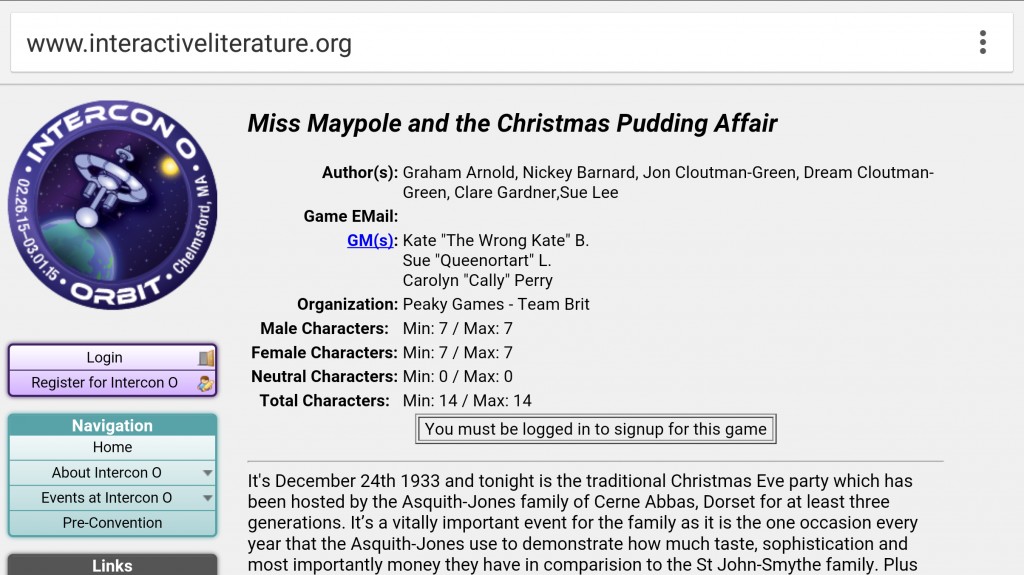
For example, in Miss Maypole and the Christmas Pudding Affair a Peaky Games larp which ran at Intercon O, Maury played Wisteria Asquith-Jones, who was pre-written as female, age 57 (though a timeless beauty), married, and having a long-standing affair with the patriarch of a rival family. Ben played Teddy St. John-Smythe, a naive young male who used the Christmas party to pursue available women until his true family heritage was revealed. GMs assigned us to these roles based on our casting questionnaire information and their own preferences for the look and feel of each character, so that their prewritten characters were brought to life with believability and verisimilitude by appropriate player bodies and performances. Players were expected to encode the characters with plausible markers of the gender and sexuality that were written, so that other players could properly decode them and gauge their own interactions and immersion. Did Ben look and behave like a dashing young rake, for example? Did Maury embody the conservative British aristocratic woman keeping up appearances at a dinner party as things fell apart around her? Was it believable that her character was “a timeless beauty” who would be at the center of a love triangle and rivalry? An affirmative answer to these questions helps create immersion into the scenario and tends to positively affect other people’s play.
Whereas the characters’ sexual orientations were merely implicit in Miss Maypole, characters were assigned both a gender and a sexuality in Bad Apples, which ran at Intercon N and O. In this game, Maury played Nina Reddy-Murphy, who was a 32-year-old, bisexual woman. Gameplay required Nina to have relationships with her in-game husband (a secretly gay man), her in-game lover (a bisexual man) and any “other characters you find attractive,” regardless of their portrayed gender. The character description indicated that Nina had had several relationships with other women, was interested in a threesome with her husband and lover, and in exploring additional sexual relationships. The game was forthright in letting players know ahead of time that it would include such portrayals, and GMs made casting decisions based on player preferences as indicated on an extensive casting questionnaire. Player genders and sexualities did not necessarily correspond to character genders and sexualities, but for the performances to be believable players had to have a certain knowledge of and comfort with portraying non-normative genders and sexualities, as well as interacting with other characters expressing them. Players sought to embody those performances based on their own understandings of gender and sexuality, informed by out-of-game normativities and their own experiences, and then conformed to the pre-written role. Casting from player preferences indicated on the questionnaire helped to ensure that players were given a role within their comfort level as well as to help avoid problematic caricatures of gender and sexuality that could have arisen. However, since a larp is interactive and character relationships rely on both parties agreeing to participate, pre-written sexualities and queer relationships can flounder when there is a disparity among players’ comfort levels and awareness. Players need to trust each other enough to risk portraying non-normative genders and/or sexualities as there may be in- and out-of-game consequences.
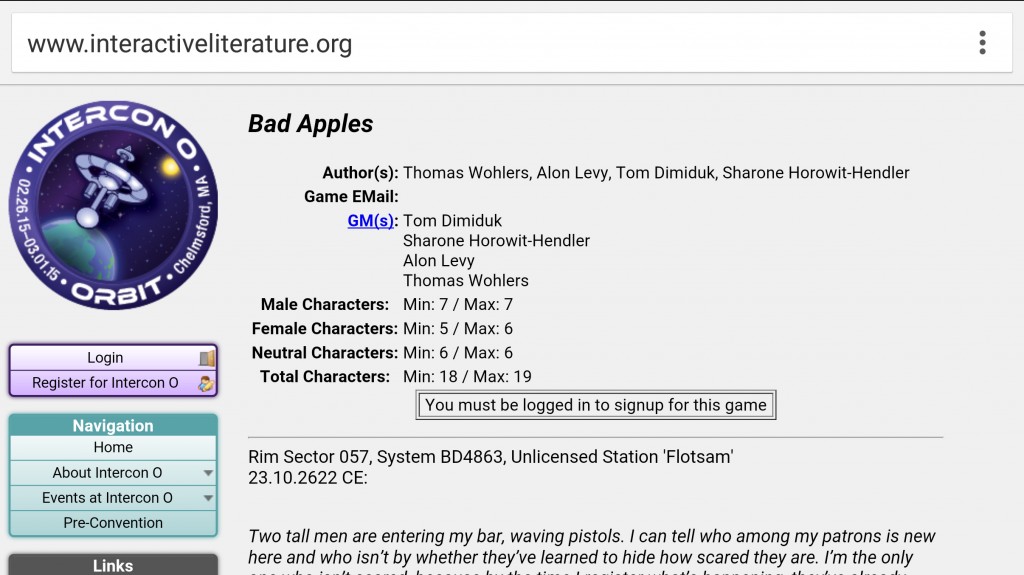
Gender-Neutral Larp Design
However, it is possible to use a different game design that writes all characters without a predetermined and pre-assigned gender, leaving the choice of gender expression up to individual players. For example, College of Wizardry, a highly immersive European larp held at a Polish castle, uses the design principle of writing all 130+ characters as gender neutral. This larp was first run in November 2014, and players portrayed college students, professors, and staff at a four-day event that simulated a hidden wizarding world inspired by Harry Potter. Maury played in the inaugural run, and both Ben and Maury played in the sequel in April 2015. In addition to being participant-observers, Ben and Maury are part of the design team for future College of Wizardry runs in Europe, and we have written or revised many of the characters for gender neutrality, complexity, depth, and player agency. As we write and design a completely new wizarding universe based on North American magical lore and history, we are using an expanded gender-neutral design.
By “gender-neutral” we mean that the character is written without a pre-determined or assigned gender, and that all descriptions eschew gendered pronouns or idioms, metaphors, or other rhetorical devices that convey a particular gender expression. Writing characters as gender-neutral does not mean that gender is removed from the game, only from the character sheets themselves. Unlike in the examples discussed above, narratives in gender-neutral larp design are not dependent on any particular character being any fixed gender. Characters are written with a surname and a first initial, and descriptions are written in the second person to address the participant. After the character is cast, the player adds gender-specific elements as they flesh out the concept presented to them. Gender identity is their own choice, not a forced determination by an external authority figure. Some players may choose to explore gender expressions different from those they portray and are perceived as outside of the game, and some may choose non-binary identities. After choosing their character’s gender expression and orientation, the CoW design then asks them to collaborate with other players (using online tools such as Facebook groups and online forums) to determine their character’s relationships and romantic attachments. Rather than face the stress of being cast in circumstances outside their comfort zone, players choose both the gender expression of the character and their relations at their own initiative and comfort level.
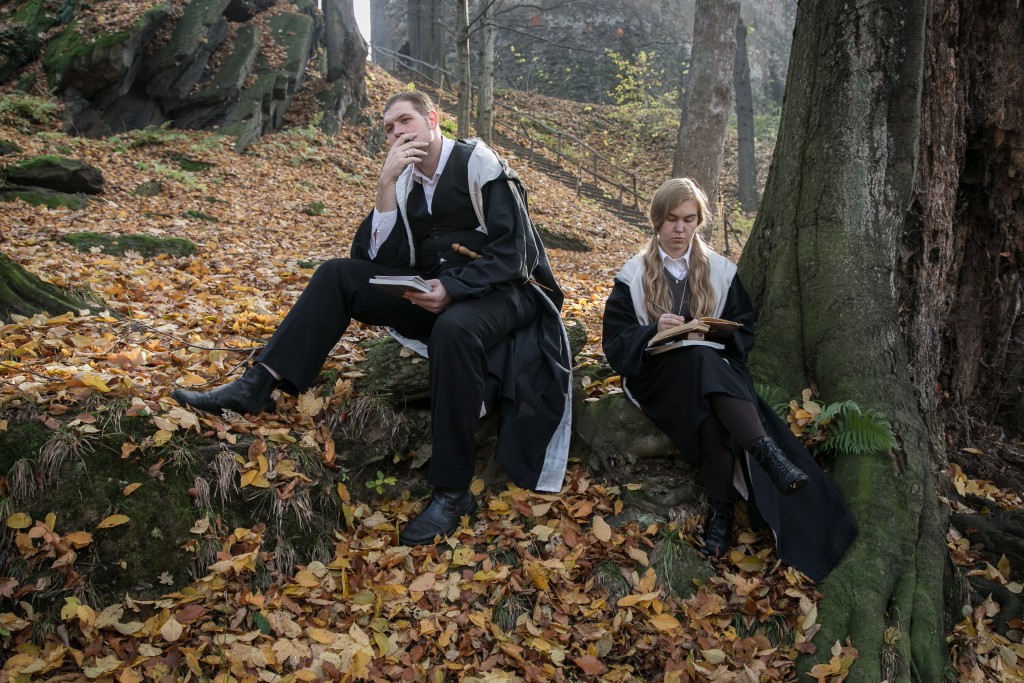
Letting players carry the weight of gendering their character alleviates a common logistical problem in mainstream theatre-style larp design, in which gendered characters are pre-written and then cast according to the available players’ gender preferences. Many organizers have found themselves in a scenario where their larp has enough player interest to be run, but the players themselves do not necessarily conform to the gendered characters as written. Such a circumstance often results in players playing outside their comfort zone, or hasty rewrites that might also challenge players’ comfort zones when character relationships now change to a different dynamic. Writing the characters as gender-neutral, however, allows for any combination of participants, as any player added to the game can be cast as any of the remaining characters, regardless of their out-of-game gender identity, desire to play a particular gender, or function within the game.
However, escaping one’s biases, politics, and out-of-game gender ideologies as a game designer isn’t easy, and designing gender-neutral characters does not necessarily ensure queer identities are represented in the game. Larp, as a medium, allows for player choice that may subvert the game designer’s intentions, especially if more than one player reinforces certain ideas or types of play. In other words, removing gender identity from the character design allows freedom of choice just as much as it allows players to universally adopt cisnormative and heteronormative roles and relationships by default. Powerful out-of-game normativities tend to bleed into game play, and although all gender identities and expressions may be allowed through a gender-neutral design, the result may nonetheless be a lack of queer identities and relationships altogether. Gender-neutral casting, then, can inadvertently result in the privileging of certain types of identities seen as more palatable or sanctioned by the cis-het dominant out-of-game hierarchies, especially if other portions of the game design—or the emergent play—tend to reinforce binary identities, assume heteronormativity, or privilege certain queer identities and sexualities over another. For example, bisexual women are often fetishized by cis-heterosexual males, as are lesbian relationships. These queer expressions may be somewhat more privileged and perhaps involve less risk of portrayal in a game. For the same reason, strict societal masculinity standards tend to disincentivize men from exploring varying gender expressions or portraying a non-heterosexual identity. As a result, women may feel more able than men to portray queer identities and relationships in games whose design and ethos ostensibly allow any player to choose any identity and sexual preference.
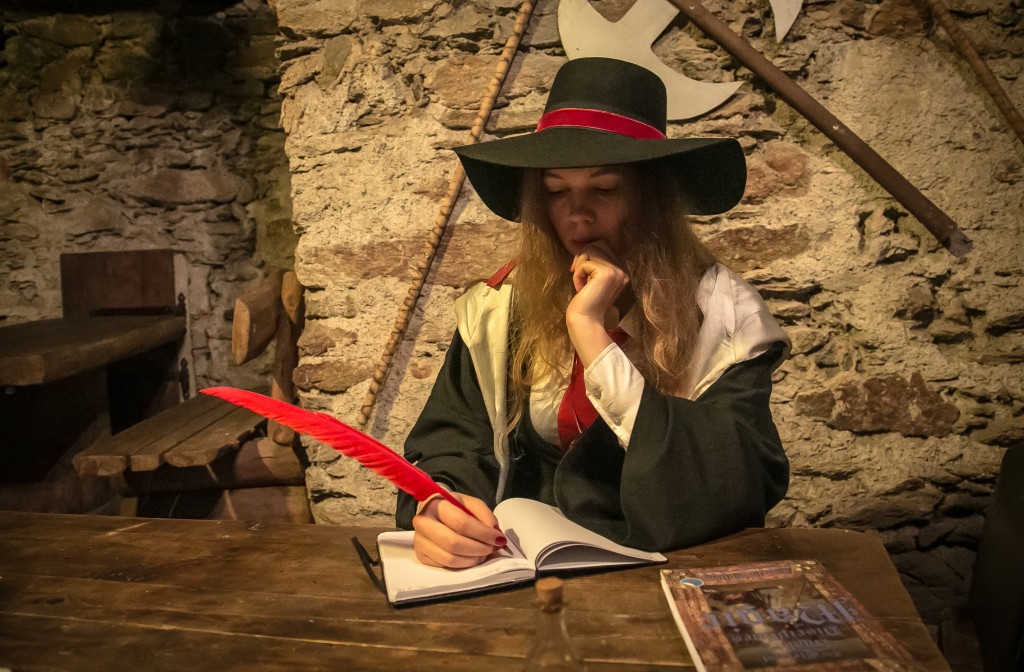
These complications occurred in College of Wizardry in November 2014 and April 2015, where—although a few players chose to express multiple forms of gender, including gender-fluid and agender—the majority of players chose a binary male or female identity. Furthermore, players of non-binary gendered characters ran up against the problem of the in-game titles of “witch” for assumed female characters and “wizard” for assumed male characters. Some players worked around such gendered appellations by creating the portmanteau “witchard.” Gender and sexuality of a character became an integral part of the game as a result of the game’s concluding event: a traditional ball for which every student had to obtain a date. This plot element required that a player’s gender and sexuality become a topic of conversation and an opportunity for misrepresentation and misunderstanding of a certain encoded performance. As in society outside the game, bisexuality was mainly erased as characters were assumed to be either heterosexual or homosexual by default. The gender-fluid characters who used plural pronouns were a source of confusion as other players attempted to reconcile these non-normative performances with the traditional norms of male-female heterosexual dates for a dance. Sometimes another character’s actions or dialogue reinforced a heteronormative default, such as when asking whether a particular character had obtained a date for the ball using the assumption of a dominant gender identity or sexual preference. While these could be corrected by the character who was misgendered or whose sexual orientation was wrongly assumed, the presence of such default assumptions exposes how resilient these categories can be.
Conclusion
While games can be written that open spaces to question the performative nature of gender and sexuality or to challenge a reliance on gender binary categories to determine player roles and character relationships, the design itself does not ensure that non-binary expressions of gender and/or non-heterosexual relationships will emerge in the game. Strong cultural influences from out-of-game, as well as an insider gamer culture that tends to reinforce a binary classification system and assumptions of default heterosexuality, create implicit rules of play that may limit what players find to be believable or possible in a given game, regardless of whether it is a mainstream theatre-style larp or a gender-neutral larp. Players bring to any game their own expectations of what it means to be male or female. These expectations are derived from out-of-game norms as well as from in-game conventions, representations, and traditions, themselves based on normative gender performances over time. Players, as characters, react to other characters based on a shared understanding of these gendered performances, operating from within an insider semiotic system that comprises both out-of-game and in-game elements in order to make meaning. Since players have to share a co-created world in a larp, agreed-upon visual and verbal cues—including gender and sexuality—that determine interaction with another character are an important part of play.
The presence of a physical body in a larp—as opposed to a representation of gender through artwork on a card, as a miniature or token in a tabletop game, or a customized avatar in a video game—brings a level of physicality that can constrain believable gender expression and affect the choices other players make, thus affecting the game’s narrative and outcome. Actual bodies in play also introduce other physical elements such as sensory experiences, pheromones, proximity, and potentially touch that affect game play, invoke out-of-game relational or sexual interactions, and also make gender more clearly performative than representational. When an actual player body is incongruous with the character concept—either as a result of the player’s presented gender or deviance from dominant ideas of gendered attributes such as beauty or strength—the believability of the character performance is affected.
Since player expectations can reinforce gender and sexual normativity as the default, a game design that does not counter these norms can create a situation where players that fall outside default normativities, by gender, by sexual orientation, by appearance, by body type, or other factors, are at risk of having a marginalized game experience. While writing characters that allow the players to make decisions regarding character gender does create more player agency than having character gender and/or sexuality pre-assigned, the constraints on gender expression do not always emerge from game design but through the normativities that designers and players bring from their culture to the game. As a result, game design itself cannot alleviate the gender trouble we can experience in larp, but better game design can mitigate some of the stress and discomfort and help create the space and opportunities for inclusion of expressions of gender and sexuality that exist outside the default normativities.
—
Featured image by Xi on Flickr, licensed under CC BY-NC-ND.
—
Maury Elizabeth Brown is the co-founder of Learn Larp, LLC, a games design and educational consulting company. She is also an assistant professor of English at Germanna Community College and a PhD Candidate in Rhetoric & Cultural Studies at Old Dominion University, where her dissertation focuses on agency in larps, particularly with respect to gender.
Benjamin A. Morrow is the co-founder of Learn Larp, LLC, a games design and educational consulting company dedicated to showcasing the power of live action role play to engage the imagination, cultivate empathy, and change hearts and minds in meaningful ways. He is also an independent games designer who has presented at Interconand blogs at inexorableprogress.com.

